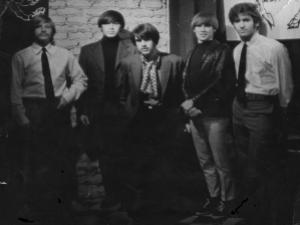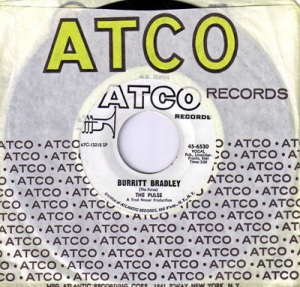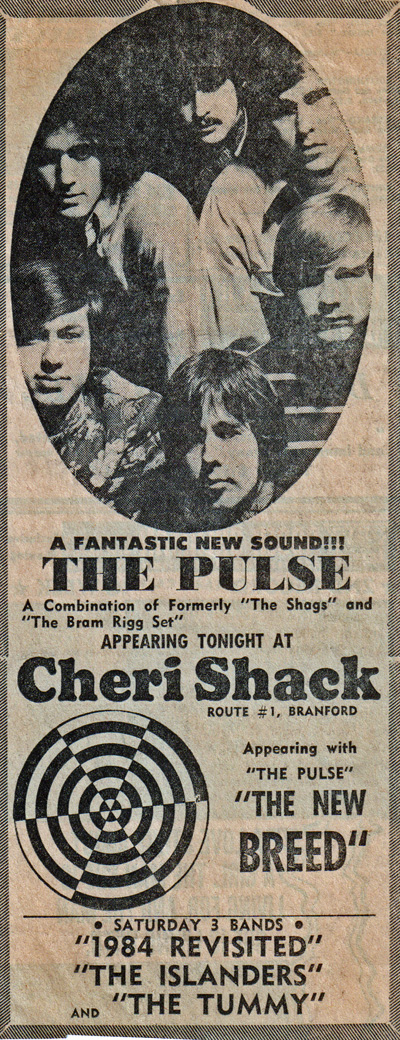I touched on a sliver of Connecticut Rock ‘n Roll in the ’60s in a previous post. Here is a little more of the story, particularly to clear up some misconceptions and inaccuracies that have been on the web for a long time.
 Pulse was a group formed from the ashes of two bands managed by Doc Cavalier, who owned Syncron Studios in Wallingford, later Trod Nossel. One was the Bram Rigg Set (left), who had formed in 1966 and had a single on Kayden, I Can Only Give You Everything, the other the Shags, who had enjoyed great popularity in New Haven and the state for several years with singles such as Wait And See and Hey Little Girl. Both broke up in the summer of 1967.
Pulse was a group formed from the ashes of two bands managed by Doc Cavalier, who owned Syncron Studios in Wallingford, later Trod Nossel. One was the Bram Rigg Set (left), who had formed in 1966 and had a single on Kayden, I Can Only Give You Everything, the other the Shags, who had enjoyed great popularity in New Haven and the state for several years with singles such as Wait And See and Hey Little Girl. Both broke up in the summer of 1967.
The break-ups were motivated by Doc to form one stronger group from the two. I had been with the Bram Rigg Set for only about six months and toward the end of that time the band was fracturing. In 1967, our lead singer Bob Schlosser was already living in Rhode Island and by the summer we were not rehearsing as a full band and usually only playing on weekends. The Shags had several regional hit singles to their credit but their popularity was waning a bit.
The first version of the band, which was called The Pulse, note the subtle difference, was made up of three members of the Shags and three from the Bram Rigg Set. From the Shags – Carl Donnell, vocals and guitar, Tommy Roberts; vocals and guitar and Lance Gardiner, bass; from Bram Rigg – Beau Segal, drums, Peter Neri, guitar and Rich Bednarcyk, keyboards.
There are a couple of interviews out there that say this group had two bass players and I was one of them. That’s ridiculous, there were never two bass players. I never rehearsed with this version of the band. Since I was going to school in Boston, first to Boston University and then Berklee School (later College) of Music, I was just not available. And I’m sure Roberts wanted Lance in the band. That was fine with me at the time, despite my missing playing with Beau, Peter and Rich, with whom I’d formed a strong musical bond.
The Pulse went into the studio and started recording. From what I gleaned from Beau they were trying to come up with a single. They did and Doc sold it to ATCO, a subsidiary of Atlantic. Unfortunately the tune was Can-Can Girl, a bubble gum confection written by Roberts with the famous Can-Can melody on horns grafted into the middle of it. It quickly disappeared. The B side, a little more esoteric, was called Burritt Bradley. The single can still be found on eBay as well as record fairs for about $40.
This went on for about six months. I’m not sure what exactly precipitated the breakup but by the beginning of 1968 I received a phone call from Beau and he asked me if I wanted to be in Pulse, a new version of the group that would be a blues-rock based outfit. I said yes and ruined my college life, well to some extent. Because for the next four months or so I commuted on weekends to Wallingford for rehersals. But it was well worth it.
In fact, it was quite a heady time for me musically. During the week, I was studying doublebasse with an extraordinary player, Nate Hygelund. I had bought a beautiful Czechoslovakian bass in Boston and a french bow and was learning classical pieces even though Berklee was a jazz school. Looking back, what’s funny, considering Berklee has become more of a contemporary music school with strong jazz roots, is that electric bass was a non-entity at the school. It didn’t exist.
I’ll never forget near the end of the semester, Nate brought an electric bass he picked up into a rehersal room I was practicing in to ask me what I thought about it because he had no idea. He had gotten lucky. He had a weathered but beautiful Fender Precision he bought for a song. He planned to use it on some pickup gigs around town.
It was a truly amazing atmosphere to be in. I was studying arranging with Herb Pomeroy, the inspirational trumpet player and teacher, and alto sax player John LaPorta! I mean John LaPorta had played with Charlie Mingus for freak’s sakes. Pomeroy on occasion played with a faculty sextet around Boston that included Charlie Mariano, another legend who recorded on Impulse, played with many greats from that label and had been married to Toshiko Akioshi, who would later lead one of the greatest big bands in the world.
Another wonderful thing about being at Berklee was it had an extensive reel-to-reel tape section in its library on the top floor of the old building on Bolyston Street, where all the classrooms were housed. I spent hours and hours listening to everything from Coltrane to Miles to Monk to Mingus. They actually had a copy of Sgt. Pepper’s, so the school was getting hip to pop and rock, but for the most part I just absorbed all of this great jazz from the late ’40s to mid-’60s, discovering all kinds of musicians I had not been exposed to such as Eric Dolphy, who played with Trane, and John Handy, who was on some Mingus sessions as well as leading his own quintet, and so many more.
One last thing about Boston. I went to Club 47 in Cambridge that semester to see the Gary Burton Quartet, one of the first true fusion bands. Burton was an alum of Berklee who played vibes like few others. He had recruited a young guitar player, Larry Coryell, who is still one of the only players I’ve ever heard who can cross over from jazz to rock and back and not sound like he’s a jazz player playing rock. Bobby Moses was the drummer and the inventive Steve Swallow the bassist. It was definitely one of the most memorable concerts I’ve seen and believe me I’ve seen hundreds over the years. My date had to drag me out of the club after their second set because she had to get back to her dorm.
All that was during the week. On the weekend, I was in a very hip blues-rock group with my best friends. You couldn’t ask for much more.
More later.
 The album is heavily blues-rock oriented and most of the tracks are in the four-to-five minute range with some longer. But this track, which was written by our drummer Beau Segal and Harvey Thurott, a guitarist and friend who would become a member of the four-piece Pulse in 1970, shows another side of the band and is packed with just about everything you can fit into 2 minutes, 36 seconds.
The album is heavily blues-rock oriented and most of the tracks are in the four-to-five minute range with some longer. But this track, which was written by our drummer Beau Segal and Harvey Thurott, a guitarist and friend who would become a member of the four-piece Pulse in 1970, shows another side of the band and is packed with just about everything you can fit into 2 minutes, 36 seconds.

 I don’t recall anyone buying the mono version. Perhaps if you couldn’t afford the $1 extra for stereo, because that’s all it was. But that’s not the point. The way to listen to Sgt. Pepper’s back then, as it is now, was in stereo.
I don’t recall anyone buying the mono version. Perhaps if you couldn’t afford the $1 extra for stereo, because that’s all it was. But that’s not the point. The way to listen to Sgt. Pepper’s back then, as it is now, was in stereo. I caught The Beehive Queen and her remarkable band Rebel Montez Saturday night at Cafe Nine, a tiny club that might hold 200, in New Haven, Connecticut. Chris showed why she is one of the state’s legendary R&B/soul singers as I watched her play the first of two 90-minute sets that included original tunes from each of her five albums and a number of meticulously chosen covers that not only put her vast talents on full display but also carried a sense of blues and soul history.
I caught The Beehive Queen and her remarkable band Rebel Montez Saturday night at Cafe Nine, a tiny club that might hold 200, in New Haven, Connecticut. Chris showed why she is one of the state’s legendary R&B/soul singers as I watched her play the first of two 90-minute sets that included original tunes from each of her five albums and a number of meticulously chosen covers that not only put her vast talents on full display but also carried a sense of blues and soul history. In January, 1968, Pulse started rehearsing in earnest to play some live dates and start recording its first album. The first gig was to be at a small club in Watertown, the Shack. We used to rehearse in what was called the Shed in back of Syncron Studios. The rehearsal room was an unfinished concrete-floored area no larger than a two-car garage with 2×4 framing exposed on the first floor of what looked like an old barn. This was perhaps the most dangerous place I’ve ever rehearsed, yet we carried on in the Shed for 2-plus years as Pulse.
In January, 1968, Pulse started rehearsing in earnest to play some live dates and start recording its first album. The first gig was to be at a small club in Watertown, the Shack. We used to rehearse in what was called the Shed in back of Syncron Studios. The rehearsal room was an unfinished concrete-floored area no larger than a two-car garage with 2×4 framing exposed on the first floor of what looked like an old barn. This was perhaps the most dangerous place I’ve ever rehearsed, yet we carried on in the Shed for 2-plus years as Pulse. Soon after forming, we added a sixth member, Jeff Potter, who played a mean blues harp and also added percussion with a conga drum and eventually occasional keyboards. Ray Zeiner, the keyboard player from the Wildweeds, had recommended him. Jeff and Ray lived next door to each other right down on the Connecticut River up near Hartford. Those houses are no longer there since the area flooded every so often. The Weeds had recently come into the fold with Doc (via their terrific single No Good To Cry) and Jeff had grown up and gone to Windsor High with Al Anderson and other members of the band.
Soon after forming, we added a sixth member, Jeff Potter, who played a mean blues harp and also added percussion with a conga drum and eventually occasional keyboards. Ray Zeiner, the keyboard player from the Wildweeds, had recommended him. Jeff and Ray lived next door to each other right down on the Connecticut River up near Hartford. Those houses are no longer there since the area flooded every so often. The Weeds had recently come into the fold with Doc (via their terrific single No Good To Cry) and Jeff had grown up and gone to Windsor High with Al Anderson and other members of the band. Pulse was a group formed from the ashes of two bands managed by Doc Cavalier, who owned Syncron Studios in Wallingford, later Trod Nossel. One was the Bram Rigg Set (left), who had formed in 1966 and had a single on Kayden, I Can Only Give You Everything, the other the Shags, who had enjoyed great popularity in New Haven and the state for several years with singles such as Wait And See and Hey Little Girl. Both broke up in the summer of 1967.
Pulse was a group formed from the ashes of two bands managed by Doc Cavalier, who owned Syncron Studios in Wallingford, later Trod Nossel. One was the Bram Rigg Set (left), who had formed in 1966 and had a single on Kayden, I Can Only Give You Everything, the other the Shags, who had enjoyed great popularity in New Haven and the state for several years with singles such as Wait And See and Hey Little Girl. Both broke up in the summer of 1967.

 While I’m at it, Christine, who has sung with the Saturday Night Live band for years, has just released a retrospective, Re-Hive, with her band Rebel Montez, which is still very active on the Connecticut circuit.
While I’m at it, Christine, who has sung with the Saturday Night Live band for years, has just released a retrospective, Re-Hive, with her band Rebel Montez, which is still very active on the Connecticut circuit.